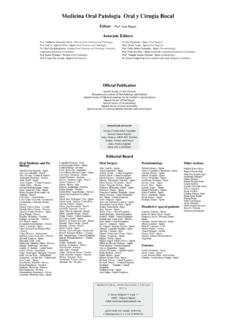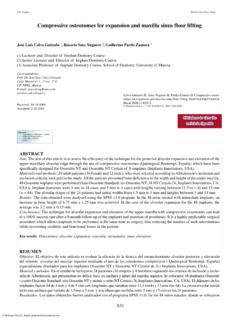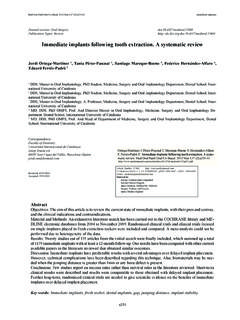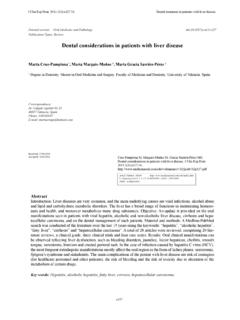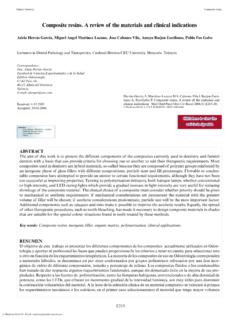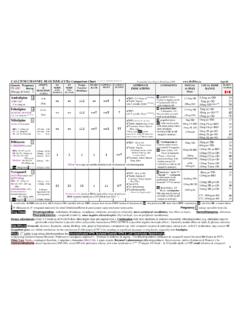Transcription of Histopathological findings in oral lichen planus …
1 Med oral Patol oral Cir Bucal. 2011 Aug 1;16 (5):e641-6. oral lichen planus : Clinical manifestations and histologye641 Journal section: oral Medicine and PathologyPublication Types: ResearchHistopathological findings in oral lichen planus and their correlation with the clinical manifestationsFrancisca Fern ndez-Gonz lez 1, Roc o V zquez- lvarez 2, Dolores Reboiras-L pez 3, Pilar G ndara-Vila 4, Abel Garc a-Garc a 5, Jos -Manuel G ndara-Rey 61 Dentist and Student of the Master s in oral Medicine, oral Surgery and Implantology School of Medicine and Dentistry of the University of Santiago de Compostela2 Dentist and Student of the Master s in oral Medicine, oral Surgery and Implantology School of Medicine and Dentistry of the University of Santiago de Compostela3 Dentist with a Master s in oral Medicine, oral Surgery and Implantology4 Dentist with a Master s in oral Medicine, oral Surgery and Implantology5 Maxillofacial Surgeon.
2 Professor of oral Surgery and Director of the Master s in oral Medicine, oral Surgery and Implantology at the School of Medicine and Dentistry of the University of Santiago de Compostela. Head of the Department of Maxillofacial Surgery at the Provincial Hospital of Santiago de Compostela6 Stomatologist, Full Professor of oral Medicine and Director of the Master s in oral Medicine, oral Surgery and Implantology at the School of Medicine and Dentistry of the University of Santiago de CompostelaCorrespondence:School of Dentistryc/ Entrerr os, s/n15782 Santiago de Compostela- A Coru a 07/01/2010 Accepted: 18/03/2010 AbstractObjectives: To highlight the most characteristic Histopathological findings of oral lichen planus and their correla-tion with the clinical manifestations and forms.
3 Study design: We performed a retrospective study of 50 biopsied and diagnosed cases of oral lichen planus ob-tained over a period of 11 years, spanning from May 1998 to April 2009. We analyzed the age and sex of the patient, type of lichen planus , location and different Histopathological findings , comparing them with the clinical lesions. Results: Seventy eight percent of the patients are female and 22% are male, with an average age of years for both sexes. The most frequent clinical form is reticular, present in 78% of the cases, and the most common location is the buccal mucosa, present in 70% of the patients. Hydropic degeneration of the basal layer and lymphocytic infiltration in the subepithelial layer are observed in the entire sample.
4 Signs of atypia were identified in 4% of the cases, but without dysplasic features. Other common histological findings were the presence of necrotic keratino-cytes (92%), hyperplasia (54%), hyperkeratosis (66%), acanthosis (48%), and less frequently, serrated ridges (30%) and the presence plasma cells (26%).Fern ndez-Gonz lez F, V zquez- lvarez R, Reboiras-L pez D, G ndara-Vila P, Garc a-Garc a A, G ndara-Rey JM. Histopathological findings in oral lichen planus and their correlation with the clinical manifestations. Med oral Patol oral Cir Bucal. 2011 Aug 1;16 (5):e641-6. Number: 16983 Medicina oral S. L. B 96689336 - pISSN 1698-4447 - eISSN: 1698-6946eMail: Indexed in: Science Citation Index ExpandedJournal Citation ReportsIndex Medicus, MEDLINE, PubMedScopus, Embase and Emcare Indice M dico Espa oral Patol oral Cir Bucal.
5 2011 Aug 1;16 (5):e641-6. oral lichen planus : clinical manifestations and histologye642 Conclusions: oral lichen planus is a disease that is more common in women, usually appearing in the fifth and sixth decades of life. The most common clinical form is reticular, manifesting mainly in the buccal mucosa. Histological findings characteristic of oral lichen planus include hydropic degeneration of the basal layer, lymphocytic infiltration in the subepithelial layer and the absence of epithelial dysplasia; however, it is also frequent to observe hyperplasia phenomena at the epithelial level, hyperkeratosis, acanthosis and the presence of necrotic keratinocytes.
6 Key words: oral lichen planus , Histopathological findings , clinical lichen planus is a chronic inflammatory and au-toimmune disease (1), affecting approximately 1 to 2% of the population (2), mainly females, and manifesting most frequently during the fifth and sixth decades of life (3). It is currently considered a disease of unknown etiology and with a multifactorial pathogenesis (1). It is believed that the T CD8+ lymphocytes which are responsible for apoptosis that occurs at the epithelial level play a fundamental role in its manifestation (4). oral lichen planus can manifest in the oral mucosa, skin, nails, scalp and other mucosas. In general, oral le-sions usually appear before skin lesions, and sometimes the lesions only appear orally (5).
7 In the mouth, the area most commonly affected is the buccal mucosa, although it may also manifest on the tongue, gingiva and/or the palate (3).Various clinical classifications of oral lichen planus have been proposed. These classifications include that suggested by Silverman, who distinguishes three types: reticular, atrophic and erosive (6). The reticular form usually appears symmetrically on the buccal mucosa and presents few symptoms (6). It is common to observe the atrophic form at the buccal, lingual and/or gingival level, with the latter appearing in the form of desquama-tive gingivitis (1). The erosive form primarily manifests in the buccal mucosa and lingual dorsum, and it along with the atrophic form, presents the most symptoms (7).
8 The diagnosis of oral lichen planus is first obtained based on the clinical appearance of the lesions, and is subsequently confirmed by a biopsy and a histopatho-logical study (7). The majority of authors agree that a biopsy is necessary, given that it allows us to confirm the clinical diagnosis and make the differential diagno-sis with other lesions (7).There are a number of lesions that are similar to oral lichen planus , both from a clinical as well as a histologi-cal standpoint. They are called lichenoid reactions , which have a known cause and include lichenoid con-tact lesions, drug-induced lichenoid reactions and li-chenoid reactions in graft versus host reaction (8). The difference between a lichen planus and a lichenoid reac-tion is determined by a series of clinical and histological criteria of the lichen planus itself, which the lichenoid reaction does not meet in its entirety (9).
9 The clinical criteria include the bilateral presence of symmetrical lesions and white reticular lesions. The le-sions may be atrophic, erosive, bullous or manifest in the form of plaque, appearing along with reticular lesions in a given area of the oral cavity. If both criteria are met, it is considered a typical lichen planus . Lesions that simulate a lichen planus but do not meet the above criteria are con-sidered to be clinically compatible with lichen histological criteria include the existence of a band of lymphocytic inflammatory infiltrate in the subepi-thelial connective tissue, hydropic degeneration of the basal layer and the absence of epithelial dysplasia. If the above three criteria are met, the lesion is considered a typical lichen planus from a histological perspective; and as for those that do not meet one of the histological criteria, they are considered to be lesions that are histo-logically compatible with lichen differential diagnosis between lichen planus and lichenoid reaction will be based on the combination of the clinical and histological aspects previously men-tioned (9).
10 Thus, all of the clinical and histological crite-ria must be met in the case of lichen planus . Conversely, lichenoid reaction includes patients with typical lichen planus clinically but not histologically, patients with typical lichen planus histologically but not clinically, and patients who are both clinically and histologically only compatible with lichen planus (9).The objective of treating lichen planus is to control the different outbreaks that exist, given that the lesions are usually not completely cured. Such treatment differs ac-cording to the clinical form present in each case. Gen-erally, the reticular forms are not treated, whereas the atrophic and erosive forms are primarily treated with topical corticosteroids.
